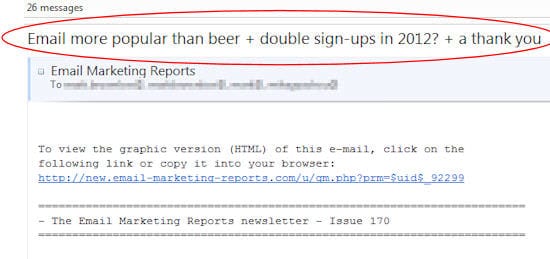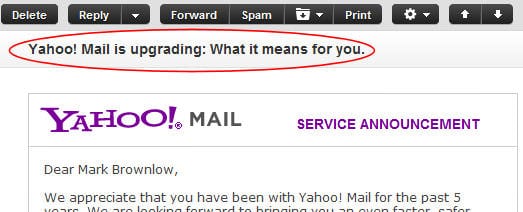Why it pays to review your subject line length and purpose
What we think influences what we say, and what we say influences what we think.
Now what has that got to do with subject lines?
Well, it starts with our certainty that we pretty much know what works and what doesn't. You see similar advice in many places: don't use all capitals, keep it short...that sort of thing.
It's dangerous to rely on intuition and experience all the time
Repeating subject line mantras doesn't always make them right. The fact is, our intuition and experience are not always accurate guides to what works best.
And if you think otherwise, Which Test Won will quickly dispel any illusions.
Consider, for example, Tumbleweed Tiny House Company... when it tested a normal subject line against the all-capitals version, the latter got more opens - not what you'd expect at all.
All caps works for Overstock, too.
And keep it short? Well, sort of.
Alchemy Worx's iconic study showed how longer subject lines can actually mean more clicks in the right circumstances.
Subject line role and length
So let's at least agree we can have short and long subject lines. And that they're important for getting attention, interest and an open in that magical place we call the inbox.
Seems reasonable.
That self-evident understanding of the role and length of the subject line can lead us astray too. Sometimes badly, sometimes trivially...and sometimes humorously.
For example, the subject line is about more than just inbox attention and opens. It's an ad in itself, a brand impression, a reminder, potentially even a call to action that does not need an open to have a positive effect.
We've covered this before at SmartInsights. For example, here's an apt quote from an interview we did with Claire Rollinson:
"If you think of each message as delivering a subtle yet powerful brand impression and that you have 12, 52 or more opportunities a year to put your message across you would start to realize that the unopened emails are as important if not more important than the ones that get opened!"
The (full) subject line can also display as a title or headline after the email is opened. As seen here in Hotmail, the impact is particularly strong in a plain text email:

...and Yahoo! Mail:

The perils of subject line truncation
'Short' and 'long' doesn't really cover it, either.
Inboxes come in a myriad of configurations. The actual number of characters displayed in the subject line depends on the mix of email client, viewing device and user setting.
So, there's a spectrum of display lengths, from very short to very long.
When I check Gmail on my smartphone, I get as few as two words and 11 characters displayed; on my PC, I'm seeing over 80 characters.
We need to be aware not just about how our subject line looks and communicates in full, but about various intermediate lengths too.
Why does this matter?
First, the advice to ensure your important words and message are as near the front as possible takes on extra weight when you see what happens to 'good' subject lines when they're heavily truncated.
Truncated doesn't just mean cut down to 50 characters, but potentially all the way down to one or two words, as in a smartphone.
Here's a real airline subject line from my inbox:
Arrive in style - try Business Class to Cairo from only £269
That's pretty short at 62 characters. Now chop it down to 15 characters:
Arrive in style
Even this relatively short, clear subject line now becomes vague and generic.
So truncation can remove clarity from the subject; it cuts out the important words needed to adjust expectations and address a target audience.
Another real-world example:
[LIVE Webinar] Social, Mobile and Local: Why They Matter for Email Marketers
Now truncate to 56 characters (or less) and the webinar becomes one for a generic non-specific audience:
[LIVE Webinar] Social, Mobile and Local: Why They Matter
Truncation can also completely change the meaning of a subject line:
Amazon.co.uk: Pre-order the latest TV hits on DVD and Blu-ray
Truncated to 37/38 characters:
Amazon.co.uk: Pre-order the latest TV
There's even room for a little accidental humor:
"Valentine's Day Sale, 10% Off On All Children's Jewelry"
Chopped off at 45/46 characters:
Valentine's Day Sale, 10% Off On All Children
...or worse...
Add these 7 FREE-WP Plugins to your money-making arsenal
Go ahead and truncate that to 53 characters to see what I mean.
Now, not all of this is a big deal. How many email clients are set to exactly 53 characters in the subject line? The occasional glitch might be a small price to pay for a winning word combination.
And who knows, maybe the truncated version actually lifts curiosity and drives more response! Which takes us back to the idea that only proper testing can tell us what really works.
Can you, though, write subject lines in a way that minimizes any loss of impact or meaning as it gets shorter and shorter? Might a different word or a change in order help?
And in the meantime, anyone else got any other funny examples of cutoff subject lines?








